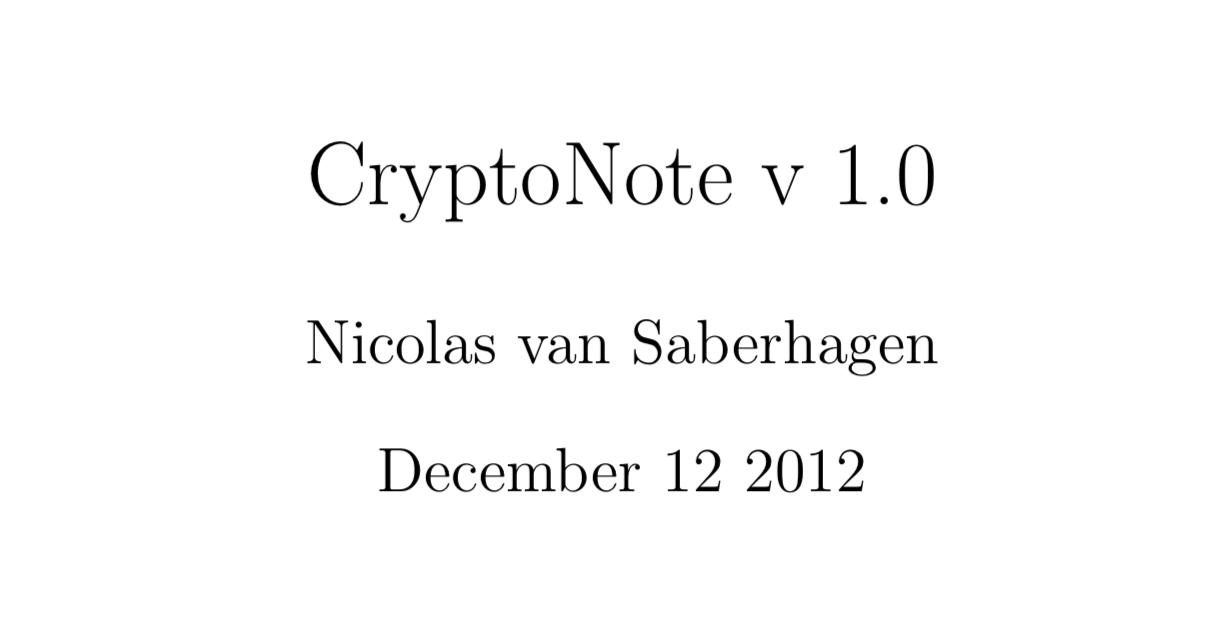
When Bitcoin first launched, the community was extremely small and it slowly grew during the first two years until the project’s creator, Satoshi Nakamoto, left the community for good. During the early years encompassing the world of cryptocurrencies, a number of anonymous individuals like Sunny King, Artforz, Rat4, and Cobra followed Satoshi’s method of keeping themselves unknown to the general public. Nicolas van Saberhagen is the person who created the Privacy-centric Cryptonote protocol. This pseudonym was used by the creator of untraceable transaction tech that led to the features found in blockchain networks Bytecoin and Monero.
Crypto’s Anonymous Personalities and the Mysterious Nicolas van Saberhagen
A number of people in the cryptocurrency community have been anonymous over the last 13-years. Anonymity is still used to create crypto projects. People creating decentralized financial (defi), and non-fungible tokens (NFT), collections continue doing so anonymously.
In the early days, after Satoshi Nakamoto left, crypto project anonymity and “ninja launches” were commonplace within the nascent digital currency environment. Artforz was an anonymous person that launched the first GPU-based mining farm.
Artforz launched Tenebrix, a cryptocurrency asset. The Tenebrix digital currency was dubbed a “CPU-friendly, GPU-hostile cryptocurrency” and Tenebrix gave birth to Scrypt as a proof-of-work (PoW) function and the crypto networks Fairbrix and Litecoin (LTC).
Sunny King (Peercoin) was also an anonymous member of the crypto community. He is the founder of PoS (proof-of-stake), and the inventor of Peercoin. Peercoin differs from other PoS networks in that PPC is a mix of PoW/PoS. King went missing for a time and an unknown creator returned to start a new project, Vee.tech. However, this never happened.

Then there’s the mysterious Nicolas van Saberhagen, the anonymous creator of the Cryptonote whitepaper. Original publication was December 12, 2012. A second edition was published October 17, 2013.
Saberhagen’s Cryptonote technology was leveraged by the blockchain network Bytecoin (BCN), a crypto asset that was created from scratch, instead of being a fork of Bitcoin. The network also has a strange background, as bitcoinwiki.org says the BCN project is “not a fork of Bitcoin in any way. Its history is completely covered in the mist: countless puzzles, unknown developers’ names, and secret messages.”
Bytecoin, Satoshi’s So-Called ‘Second Project’ and the 7-Member Cryptonote Team
Like Bytecoin, the blockchain network Monero (XMR) is also fashioned from Saberhagen’s Cryptonote technology. Not much is known about the character Saberhagen, but some have theorized that the inventor may have crafted Bytecoin (BCN) and that BCN could possibly have been “Satoshi’s second project.”

One theory is that Saberhagen was the one who created Bitcoin. Saberhagen and Saberhagen were both unknown individuals, but they both developed groundbreaking cryptographic schemes. Saberhagen, who is now part of the Stanford Blockchain Club, may also have been implicated in the Cryptonote project.

A member of Stanford Bitcoin Group, however, denied any involvement with Cryptonote cryptocurrency, white papers, or tech. The Stanford Bitcoin Group was also denied any involvement in Cryptonote technology. Furthermore, besides Saberhagen, the Cryptonote technology itself was also reportedly built by a team of individuals known as Johannes Meier, Maurice Planck, Max Jameson, Brandon Hawking, Catherine Erwin, Albert Werner, and Marec Plíškov.
I am not associated with the CryptoNote cryptocurrency project despite recent accusations https://t.co/HyKxXbF352
— Alain Meier (@alain) August 16, 2014
The article on bitcoinbarbie.com featured interviews with all seven members of the team, who use famous scientist names. The seven-member Cryptonote team doesn’t mention Saberhagen’s role at all, and they further stressed that they had no intentions of creating a cryptocurrency. The Cryptonote team remarked that before Bytecoin, there was another project called “Betanote.”
Additionally, Cryptonote technology was used by the other blockchain networks Bytecoin and Monero (XMR), Ducknote and Fantomcoin respectively. XMR, currently the biggest privacy coin, is long forgotten. Besides publishing the Cryptonote white paper, Saberhagen wasn’t heard from again until an alleged talk at the P2P Financial Systems event in 2015.
Saberhagen Allegedly Speaks in 2015, Bitcointalk.org Forum Member ‘Bytecoin’ Introduces BCN in 2010
Saberhagen had been scheduled to deliver a speech, but instead he called through Skype via a voice changer. According to some, Saberhagen was not understood by anyone and no copy of his talk is known. A bounty was also offered to Saberhagen for the talk four years back.

On April 1, 2020, monerooutreach.org published an April Fool’s Day article that claims “new evidence suggests Bitcoin founder Satoshi also created Monero.” While there’s no proof that Saberhagen and Nakamoto are the same, both creators’ inventions have created a myriad of forks. At least two dozen BCN-clones have been created since the release of Bytecoin, an open-source cryptocurrency chain that was built entirely from scratch.
While people have tried to tie Saberhagen’s persona to Satoshi Nakamoto’s identity, some have said that Saberhagen was also the original creator of Bytecoin (BCN). It has been said that Saberhagen actually called himself “Bytecoin” on bitcointalk.org as early as July 17, 2010.

Additionally, the name registered on bitcointalk.org is tied to the email “[email protected],” and gmx.com was the email domain used by Satoshi when the inventor utilized the “[email protected]” email. Even though BCN launched on America’s Independence Day (July 4) 2012, the bitcointalk.org forum member Bytecoin had been publishing posts about the subject since 2010. For instance, two years before the BCN launch, bitcointalk.org forum member Bytecoin wrote about “balance sheets” that can be forgotten.
In August 2010, Satoshi Nakamoto discussed how people can obtain blockchain privacy via “key blinding” and “group signatures.” The discussion stemmed from a conversation where users complained that Bitcoin’s “entire history of transactions is completely public.” Five days after Satoshi’s discussion, Bytecoin wrote another post about “hiding the recipient and amount until the money is spent.”
Later, the anonymous user called Bytecoin wrote about how a “wallet handling code should be a separate process.” The following year in 2011, the bitcointalk.org forum member said “untraceable transactions which can contain a secure message are inevitable.” Months later, Bytecoin wrote about “protecting privacy without generating and distributing new addresses” and all of Bytecoin’s writings and ideas proposed pre-dated the original Bytecoin (BCN) network launch in 2012.
Bytecoin’s Alleged 82% Premine and Saberhagen’s Pre-Dated Digital Signatures
Since the allegations that Bytecoin developers premined large quantities of BCN, Bytecoin is a controversial cryptocurrency. Questions arose about Saberhagen’s digital signatures in the two Cryptonote white papers and whether or not they were altered at a later date. According to Cryptonote whitepapers, version 1 was created in October 2014.

Bitcointalk.org forum member “rethink-your-strategy” claimed Bytecoin was an 82% premine, which would make it one of the largest premined coins in history, if the accusations are true. The forum member “rethink-your-strategy” added that while the creators “developed amazing technology [that] had a pretty decent implementation,” the creators were “greedy,” “scam artists,” and “Botnet creators.”
There’s a whole lot of mystery tied to Nicolas van Saberhagen, the Cryptonote team, and the creators of Bytecoin (BCN). It is not known why the Cryptonote team decided to publish Cryptonote technology and become anons. This led to the creation of many different cryptocurrency assets. Some think anonymity allows law enforcement personnel to target criminals using the technology.
Saberhagen, along with the Cryptonote Team were part of a long line of crypto community members who decided to be anons and make a secret release. In these cases, there’s never an identity to place blame on when something goes wrong within the community or network. There’s also no one to congratulate either, as secrecy and complete anonymity are top priority and essentially the name of the game.
What do you think about the mystery behind the Bytecoin project’s premine, the Cryptonote white paper author Nicolas van Saberhagen, or the Cryptonote team? Please comment below to let us know your thoughts on this topic.
Images CreditsShutterstock. Pixabay. Wiki Commons
DisclaimerThis article serves informational purposes. It does not constitute an offer, solicitation, or recommendation of products or services. Bitcoin.com is not a provider of investment, tax, legal or accounting advice. The author and the company are not responsible for any loss or damage caused or alleged caused by the content or use of any goods, services, or information mentioned in the article.